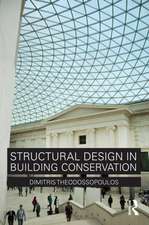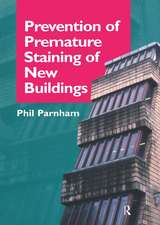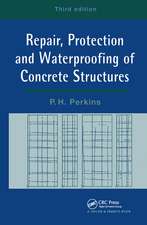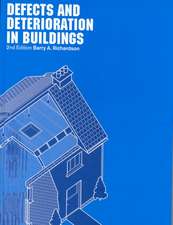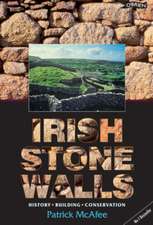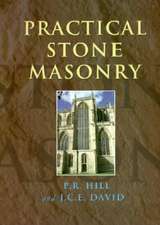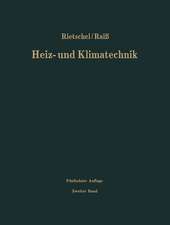Conservation of Building and Decorative Stone
Autor F G Dimes, J. Ashursten Limba Engleză Hardback – 11 apr 2016
Part one is an introduction to the complexities and background history of stone conservation followed by the most comprehensive description yet produced of the building and decorative stones used in the British Isles.
In part two, practitioners involved in stone conservation describe ways in which major structural masonry problems, secondary building problems and different stone surface conditions may be treated. A variety of building types and environments has been used to ensure that the broad scope of common problems is covered. This second part of the book will be of practical value to art historians, archaeologists, architects, surveyors and engineers, masonry contractors and sculpture conservators in solving problems and in learning to use each other's skills and experience.
Preț: 746.58 lei
Preț vechi: 1160.58 lei
-36% Nou
Puncte Express: 1120
Preț estimativ în valută:
142.88€ • 148.61$ • 117.95£
142.88€ • 148.61$ • 117.95£
Carte tipărită la comandă
Livrare economică 14-28 aprilie
Preluare comenzi: 021 569.72.76
Specificații
ISBN-13: 9781138142749
ISBN-10: 1138142743
Pagini: 464
Dimensiuni: 189 x 246 mm
Greutate: 1.02 kg
Ediția:1
Editura: Taylor & Francis
Colecția Routledge
Locul publicării:Oxford, United Kingdom
ISBN-10: 1138142743
Pagini: 464
Dimensiuni: 189 x 246 mm
Greutate: 1.02 kg
Ediția:1
Editura: Taylor & Francis
Colecția Routledge
Locul publicării:Oxford, United Kingdom
Public țintă
Professional Practice & DevelopmentCuprins
Volume One: An introduction to the restoration, conservation and repair of stone; The nature of building and decorative stones; Igneous rocks; Sedimentary rocks; Metamorphic rocks; Determination of a sample; Weathering and decay of masonry; Methods of repairing and consolidating stone buildings; Structural failure and repair; The selection of stone for repairs; Mortar for stone buildings; Traditional handwork of stone; Earthquake damage to historic masonry structures; Cleaning masonry buildings; Surface treatments; The conservation of stone monuments in churches; The conservation of stone sculpture in museums; The museum display of architectural features; The cleaning of painted stone; Appendices; Index.
Recenzii
'A conservator's manual and reference book of the highest quality.'
Context.
'An outstanding compilation of the results of study and field experience by 20 specialists..'
Society for the Protection of Ancient Buildings News
'One of the problems that beset the practical conversation of stone buildings is the fragmentation of the disciplines involved. This book, with both volumes now available as one paperback, brings these disciplines together by the involvement of contributors with different experiences and approaches to the same material.'
ASI Journal
'As a reference text, it is thorough and easily read. As a book to dip into and enjoy both the clear language and plentiful illustrations, it remains unchallenged.'
Journal of Architectural Conservation
'This book in its new combined form should rightly take its place with other standard volumes in the field.'
EASA Newsletter
Context.
'An outstanding compilation of the results of study and field experience by 20 specialists..'
Society for the Protection of Ancient Buildings News
'One of the problems that beset the practical conversation of stone buildings is the fragmentation of the disciplines involved. This book, with both volumes now available as one paperback, brings these disciplines together by the involvement of contributors with different experiences and approaches to the same material.'
ASI Journal
'As a reference text, it is thorough and easily read. As a book to dip into and enjoy both the clear language and plentiful illustrations, it remains unchallenged.'
Journal of Architectural Conservation
'This book in its new combined form should rightly take its place with other standard volumes in the field.'
EASA Newsletter
Notă biografică
John Ashurst, Francis G Dimepson
Descriere
One of the problems which beset the practical conservation of stone buildings is the fragmentation of the disciplines involved. This book, with both volumes now available as one invaluable paperback, brings these disciplines together by the involvement of contributors with different experiences and approaches to the same material.
Part one is an introduction to the complexities and background history of stone conservation followed by the most comprehensive description yet produced of the building and decorative stones used in the British Isles.
In part two, practitioners involved in stone conservation describe ways in which major structural masonry problems, secondary building problems and different stone surface conditions may be treated. A variety of building types and environments has been used to ensure that the broad scope of common problems is covered. This second part of the book will be of practical value to art historians, archaeologists, architects, surveyors and engineers, masonry contractors and sculpture conservators in solving problems and in learning to use each other's skills and experience.
Part one is an introduction to the complexities and background history of stone conservation followed by the most comprehensive description yet produced of the building and decorative stones used in the British Isles.
In part two, practitioners involved in stone conservation describe ways in which major structural masonry problems, secondary building problems and different stone surface conditions may be treated. A variety of building types and environments has been used to ensure that the broad scope of common problems is covered. This second part of the book will be of practical value to art historians, archaeologists, architects, surveyors and engineers, masonry contractors and sculpture conservators in solving problems and in learning to use each other's skills and experience.


